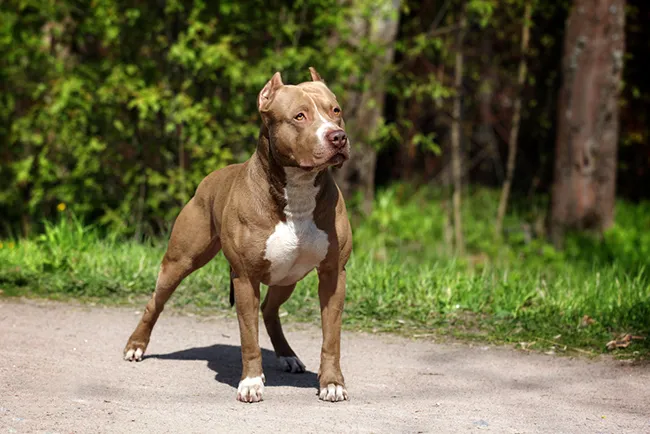Why Are Pit Bulls So Muscular?

Pit bulls often command attention with their imposing presence, characterized by a robust and muscular build, powerful legs, and a strikingly prominent chest. This physicality can contribute to the perception of pit bulls as an intimidating breed. As pet owners, it’s natural to ponder whether this muscularity is a standard feature across all pit bull breeds and how it influences their potential as affectionate companions. Questions arise about the normalcy of their muscular physique and ways to ensure their well-being while fostering a healthy and balanced relationship with these strong and loyal pets. In this exploration, we delve into the characteristics of pit bulls, addressing concerns about their physicality and offering insights on maintaining their health and muscular vigor.
Why are Pitbulls so Muscular?
Pit bulls, especially the American pit bull terrier, are muscular mainly because of their genes. They come from a mix of active breeds like terriers and bulldogs. Originally, they were bred for activities like fighting and bull-baiting, where looking strong and tough was important. Nowadays, some people breed them for sports like weight pulling and dock jumping, which are more humane. Because of their genes, pit bulls are naturally active and enjoy sports, which helps them stay muscular.
How to Support Muscle Growth in Your Pit Bull
Ensuring your pit bull’s health and promoting muscle growth involves a combination of proper nutrition, regular exercise, and attentive care, especially if your dog is a rescue and dealing with weight issues. Here are some tips to help your pit bull grow and maintain their muscles:
1. Balanced Diet
Provide a balanced and nutritious diet that meets the specific needs of your pit bull. High-quality dog food with a good protein content is crucial for muscle development. Consult with your veterinarian to determine the right type and amount of food for your dog’s individual needs.
2. Protein Intake
Protein is essential for muscle growth. Choose a dog food that contains a significant amount of quality animal-based protein. You can also include lean meats like chicken, turkey, or beef in their diet, but ensure they are cooked and bone-free.
3. Dietary Supplements
You might get a bit jittery hearing the word ‘supplements,’ but no need to fret – we’re not talking about anything wild like doggy steroids or weird hormone pills.
Dietary supplements are like bonus nutrients for your pup to recover what they burn during playtime. Think fatty Omega-oils, vitamin boosters, and antioxidants – all the good stuff!
Now, your dog may not absolutely need these extra goodies, especially if they’re rocking a well-balanced diet. But hey, it’s a nice thought to consider for their overall health.
4. Regular Exercise
Engage your pit bull in regular and varied physical activities. Activities like brisk walks, jogging, and interactive play sessions can help build and tone muscles. Incorporate activities that focus on different muscle groups to achieve an overall balanced physique.
5. Strength Training
Introduce strength training exercises that are safe for dogs. Simple activities like tug-of-war, fetch, and climbing stairs can contribute to muscle development. Be cautious with the intensity and duration, especially for a rescue dog, and gradually increase the difficulty as your pit bull becomes more conditioned.
6. Cardio Exercise
Once your dog’s got a good grub routine down, let’s shift gears to the next big thing – exercise.
Pit bulls are a lively bunch, so they probably get their fair share of exercise through regular walks, as we mentioned earlier.
But here’s the scoop: you can kick it up a notch with some high-energy cardio for muscle boostin’. Picture short bursts of serious action, like speedy sprints. A hill or a beach makes for a great workout spot.
Now, with a vet’s thumbs up, you might throw in a weighted vest for that extra oomph. Just keep an eye out for signs of your pup going into overdrive or getting too toasty during exercise. Remember, moderation is the key to cardio – too much can tire your furry friend out and actually set them back.
7. Consistent Routine
Establish a consistent daily routine for feeding and exercise. Dogs, especially rescues, thrive on routine, and a consistent schedule can help regulate their metabolism and contribute to healthy muscle development.
8. Monitor Weight
Keep a close eye on your pit bull’s weight and adjust their diet and exercise routine accordingly. If your dog is underweight, gradually increase the portion size and choose foods with higher calorie content. For overweight dogs, portion control and increased exercise can help shed excess pounds.
10. Regular Veterinary Check-ups
Schedule regular veterinary check-ups to monitor your pit bull’s overall health. Your veterinarian can provide personalized advice based on your dog’s specific needs and address any concerns regarding weight and muscle development.
Remember, each pit bull is unique, and the key is to tailor their diet and exercise routine to their individual requirements. Always consult with your veterinarian before making significant changes to your dog’s diet or exercise regimen, especially if they are a rescue with a history of health challenges.
Why Do Some Pit Bulls Struggle to Build Muscle?
Several factors can contribute to why some Pit Bulls may struggle to build muscle. Here are a few possible reasons:
1. Genetics
Just like humans, genetics play a significant role in a dog’s physical attributes, including muscle development. Some Pit Bulls may have a genetic predisposition to a leaner build, while others may naturally have a more muscular physique.
2. Health Issues
Underlying health problems, whether genetic or acquired, can affect a Pit Bull’s ability to build muscle. Conditions such as thyroid issues, nutritional deficiencies, or hormonal imbalances may hinder muscle development.
3. Poor Nutrition
A balanced and nutritious diet is crucial for muscle growth. If a Pit Bull is not receiving the necessary nutrients, especially protein, for muscle development, it can impede their ability to build and maintain muscles.
4. Lack of Exercise
Adequate exercise is essential for muscle development. If a Pit Bull is not getting enough physical activity or engaging in varied exercises, it can hinder the growth of their muscles. Regular and appropriate exercise is vital for maintaining a healthy and fit physique.
5. Age
Younger dogs generally have an easier time building muscle compared to older ones. Puppies may naturally have a more slender appearance, and it takes time for their muscles to develop fully. Older dogs may also face challenges due to aging and decreased activity levels.
6. Inconsistent Routine
Dogs thrive on routine, and inconsistency in feeding or exercise schedules can impact their overall health, including muscle development. A steady and predictable routine contributes to a Pit Bull’s well-being.
7. Pre-existing Conditions
Some Pit Bulls may have pre-existing conditions or injuries that limit their ability to engage in certain types of exercises, affecting their muscle-building potential.
8. Overexertion
On the flip side, excessive exercise without proper rest periods can lead to overexertion, fatigue, and a lack of muscle growth. Balancing exercise intensity with adequate rest is crucial for optimal muscle development.
If you’re concerned about your Pit Bull’s muscle development, it’s recommended to consult with a veterinarian. They can assess your dog’s overall health, provide guidance on nutrition and exercise, and rule out any underlying health issues that may be hindering muscle growth.
Conclusion
In conclusion, achieving and maintaining muscle health in pit bulls involves a combination of factors, including a balanced diet, regular exercise, and attentive care. While genetics, age, and individual variations play a role, providing proper nutrition, incorporating strength-building exercises, and ensuring a consistent routine contribute to a pitbulls muscular development. It’s crucial to be mindful of the dog’s overall health, consult with a veterinarian, and tailor the approach to the specific needs of the individual pit bull. With a well-rounded and considerate approach, pit bull owners can help their furry companions attain and sustain a healthy, muscular physique, promoting not only physical well-being but also overall vitality.



